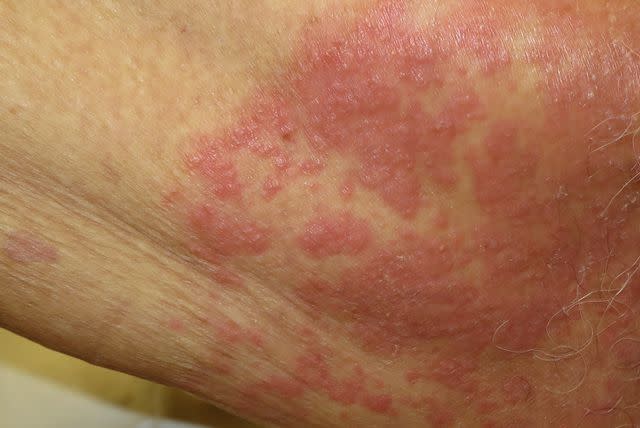Getting Rid of a Yeast Infection on Your Skin
Medically Known as Cutaneous Candidiasis
Medically reviewed by Casey Gallagher, MD
Cutaneous candidiasis is a yeast infection that affects the skin and causes a red rash accompanied by dry and scaly patches of skin. Sometimes, these scales will ooze pus or become crusty.
This article discusses ways to identify a yeast infection on the skin, its causes, and treatment for both temporary and chronic symptoms.

Zoran Zeremski / Getty Images
Identifying a Yeast Infection on Skin
A genus of yeast known as Candida always lives on the skin. Organisms, those that are always present on or within the body are called commensals. Typically, they do not cause harm and can even be beneficial by acting as part of the immune response.

Reproduced with permission from ©DermNet NZ and ©Waikato District Health Board www.dermnetnz.org 2022
Intertrigo infection from yeast on skinThat said, yeast can become overgrown. When it does grow invasively or out of control, it can lead to an infection and the rash that occurs when there is too much yeast on the skin.
A yeast infection rash can look similar to other types of rashes, making it challenging to identify. There are, however, some telltale signs to pay attention to, such as:
An abnormal thickening of the skin, known as hyperkeratosis
Skin redness and rash that continues to increase in size
Intense itching
Pimple-like bumps in the hair follicles of the affected area
Where the Rash Develops
While a yeast infection can occur on any part of the skin, it typically stays localized in a few areas, including:
Skinfolds
The genital area
The torso or middle body
Underneath the breasts
Buttocks
Learn More: Symptoms of Yeast Infections
Signs of Yeast Infection on Child’s Skin
Children may also be susceptible to a yeast infection on the skin, and it is more likely to occur in children with weakened immune systems.
The symptoms that develop in children with yeast infections on the skin are similar to those that develop in adults and include:
Red rash
Patches of skin that ooze a clear fluid
Pimples
Itching and burning
Scaling of the skin
Children may have difficulty explaining their symptoms, so it’s best to assess the look of the rash and see a healthcare provider if you suspect a yeast infection on your child’s skin.
Diagnosing Yeast Infections on the Skin
Typically, healthcare providers can diagnose yeast infections on the skin by looking at the rash. They may also collect a sample of the affected skin to test for bacteria, fungi, or other organisms causing infection. In some cases, diabetes testing will be done as high blood sugar can result in an overgrowth of yeast, with the sugar acting as a food source for the organisms.
Related: Our 7 Picks for At-Home Yeast Infection Tests of 2023
Where Does a Yeast Skin Infection Come From?
Yeast can be found within the body and on the skin at all times. When it grows normally, it doesn’t cause any issues and can act as part of the immune system to prevent disease.
However, yeast can grow out of control, leading to infection. Some things that can cause an overgrowth of yeast are:
Diabetes/consistently high blood sugar levels
Overexposure to hot and humid weather
Skin friction, such as when a child wears a wet diaper for too long
Immunodeficiencies, or a weak immune system
The use of antibiotics
The presence of other skin disorders, including eczema and psoriasis
Damage or injury to the skin
Risk Factors Associated with Skin Yeast Infections
Along with the causes mentioned above, other factors that may increase a person’s risk of developing a yeast infection on the skin include:
Excessive sweating that can lead to an increase in dampness and friction
Sharing personal items, including clothing, shoes, towels, or bedding
Wearing clothes or footwear that is too tight (not breathable)
Close contact with an animal that has the infection
Related: Are Yeast Infections Contagious?
Treating Yeast Infection on Skin Naturally
Yeast infections affecting the skin may not always require prescription medication. In some cases, you can use natural or home remedies to help cope with symptoms and clear the infection.
The first natural approach is practicing good health and hygiene. Keeping skin dry can clear up an infection and reduce the risk of recurrence.
If you have diabetes, manage your blood sugar levels. This reduces yeast's food source and keeps them from growing out of control.
Topical Treatment for Yeast Skin Infection
Natural methods can help reduce or clear up a yeast infection on the skin, but you may also need to apply a topical medicine to the area. Antifungals, which can be both over-the-counter (OTC) and prescribed, are the first choice when combatting a fungal infection on the skin.
The ingredients most used include:
Clotrimazole
Nystatin
Miconazole
The strengths of these topical medicines vary, with over-the-counter products being less potent but more widely available. The type of medicine you require will be determined by your current state of health and the severity of the infection.
At-Home Treatment vs. When to Seek Care
If you’ve had a yeast infection on your skin before, treating it at home can be an excellent way to eliminate it. Typically, a yeast infection on the skin will clear up a week after you start treatment. However, if this is a new rash, see a healthcare provider before starting any at-home remedies to get a proper diagnosis and treatment.
Learn More: 6 Best Over-the-Counter Yeast Infection Medicines of 2023
Why Some People Get Chronic Yeast Skin Infections
Chronic yeast infections are yeast infections that occur at least four times per year. Some people are more susceptible to yeast overgrowth because they provide optimal living conditions for the yeast to thrive out of control.
For example, if a person consistently avoids personal hygiene and is exposed to hot and humid conditions, damp skin, and friction, they are more likely to experience chronic skin yeast infections.
Another notable cause of chronic yeast skin infections is the functioning of the immune system. Some people with chronic yeast infections have inherited immune system disorders, such as those affecting T cells. T cells are white blood cells that protect the body from disease and illness.
When compromised, those cells cannot do their job correctly, increasing the risk of recurrent or chronic infections. Other immune cell deficiencies can also cause chronic yeast infections on the skin, including issues with neutrophils. Certain diseases, such as chronic granulomatous disease (CGD), can drive faulty neutrophils.
Other Possible Causes of Chronic Yeast Infections on the Skin
In some cases, underlying health disorders can drive chronic skin yeast infections, such as:
Diabetes
Disorders that weaken the immune system
Human immunodeficiency virus (HIV)
Organ transplant recipients
Complications of Severe Yeast Skin Infections
With proper treatment, yeast infections on the skin can clear up relatively quickly. However, complications can occur if they are severe enough or are left to continue to grow.
Some possible adverse effects of a yeast infections on the skin include:
Nail infections that cause the nails to change shape
Widespread candidiasis, where the infection spreads throughout the body
Recurrent yeast infections on the skin
Skin Yeast Infection and Invasive Candidiasis
If a skin yeast infection is severe and manages to enter the bloodstream, it can lead to a condition known as invasive candidiasis. This type of infection is serious and requires medical care.
Learn More: What Can Happen If You Leave Your Yeast Infection Untreated
Tips to Avoid Repeat or Spreading Infection From Skin Yeast
To ensure that you don’t get chronic yeast infections on the skin or cause the current rash to continue to expand, consider taking the following steps:
Practice good hygiene.
Keep your body cool and dry.
Avoid scratching the area, as it can spread the rash.
Take all medications as they were prescribed to you.
Wear loose clothing over the affected areas until the infection has cleared.
Summary
Yeast infections on the skin develop when there is too much yeast on the skin. The overgrowth causes a rash, with other symptoms including itchiness and flaky skin. While a yeast infection on the skin isn't considered a medical emergency, it can turn into one if left untreated. Take appropriate care measures and discuss treatment options with your healthcare provider. Typically, this type of yeast infection will clear up within a week of starting treatment.
Read the original article on Verywell Health.

